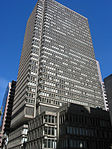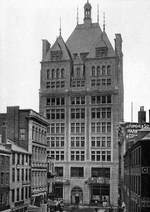Milk Street, Boston
Financial District, BostonStreets in Boston

Milk Street is a street in the financial district of Boston, Massachusetts, which was one of Boston's earliest highways. The name "Milk Street" was most likely given to the street in 1708 due to a milk market at the location, although Grace Croft's 1952 work "History and Genealogy of Milk Family" instead proposes that Milk Street may have been named for John Milk, an early shipwright in Boston. The land was originally conveyed to his father, also John Milk, in October 1666. One of the first post offices in Boston was founded on the street in 1711, when the first regular postal routes to Maine, Plymouth and New York were established.
Excerpt from the Wikipedia article Milk Street, Boston (License: CC BY-SA 3.0, Authors, Images).Milk Street, Boston
Oliver Street, Boston Downtown Boston
Geographical coordinates (GPS) Address Nearby Places Show on map
Geographical coordinates (GPS)
| Latitude | Longitude |
|---|---|
| N 42.357369444444 ° | E -71.054569444444 ° |
Address
Two Oliver Street
Oliver Street 2
02110 Boston, Downtown Boston
Massachusetts, United States
Open on Google Maps









